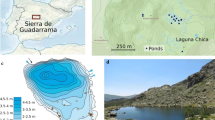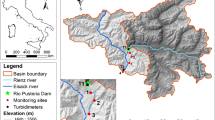Abstract
South Africa’s Cape Fold Ecoregion supports a unique freshwater fish assemblage with many endemics. To mitigate impacts of alien invasive fishes on this unique assemblage, nature conservation authority CapeNature used rotenone to remove smallmouth bass (Micropterus dolomieu) from the Rondegat River. We investigated whether the rotenone treatments had an adverse impact on the aquatic macroinvertebrate community over the long-term, the first study of its kind in Africa. We monitored macroinvertebrates within treated and untreated (control) sites on multiple sampling events for 2 years before and 2 years after two rotenone treatments. We analysed the difference in invertebrate abundance between treatment and control sites before and after treatment, using generalised linear mixed models with sampling event as a random factor to partition out natural fluctuations in abundances over time. Populations fluctuated widely in control and treatment sites over the study period, and we found no effect that could be clearly attributed to rotenone. We conclude that macroinvertebrates recovered rapidly after treatment, probably through drift from untreated areas upstream, with no long-term adverse effects. We recommend that the presence of uninvaded upstream refuges that may provide demographic rescue be used as a key discriminating factor for future conservation purposed rotenone deployments.




Similar content being viewed by others
References
Abell, R., M. L. Thieme, C. Revenga, M. T. Bryer, M. Kottelat, N. G. Bogutskaya, B. Coad, N. E. Mandrak, S. C. Balderas, W. Bussing, M. L. J. Stiassny, P. H. Skelton, G. R. Allen, P. Unmack, A. M. Naseka, R. Ng, N. Sindorf, J. Robertson, E. Armijo, J. V. Higgins, T. J. Heibel, E. Wikramanayake, D. Olson, H. L. López, R. E. Reis, J. G. Lundberg, M. H. Sabaj Pérez & P. Petry, 2008. Freshwater ecoregions of the world: a new map of biogeographic units for freshwater biodiversity conservation. BioScience 58: 403–414.
Bates, D., M. Maechler, B. Bolker & S. Walker, 2015. Fitting linear mixed-effects models using lme4. Journal of Statistical Software 67: 1–48.
Bellingan, T. A., D. J. Woodford, M. H. Gouws & O. L. F. Weyl, 2015. Rapid bioassessment of the effects of repeated rotenone treatments on invertebrate assemblages in the Rondegat River, South Africa. African Journal of Aquatic Science 40: 89–94.
Booth, A., S. Moss & O. Weyl, 2015. Effect of rotenone on gill-respiring and plastron-respiring insects. African Journal of Aquatic Science 40: 95–100.
Chandler, J. H. Jr. & L. L. Marking. 1982. Toxicity of rotenone to selected aquatic invertebrates and frog larvae. Progressive Fish-Culturist 44: 78–80.
Dalu, T., R. J. Wasserman, M. Jordaan, W. P. Froneman & O. L. F. Weyl, 2015. An assessment of the effect of rotenone on selected non-target aquatic fauna. PLoS ONE 10: 1–13.
Darwall, W. R. T., K. G. Smith, D. Tweddle & P. H. Skelton, 2009. The status and distribution of freshwater biodiversity in southern Africa. Information Press, Oxford. (South African Institute for Aquatic Biodiversity): Grahamstown, South Africa. 131 pp.
de Moor, F. C. & J. A. Day, 2013. Aquatic biodiversity in the Mediterranean region of South Africa. Hydrobiologia 719: 237–268.
Dickens, C. W. & P. M. Graham, 2002. The South African Scoring System (SASS) Version 5 Rapid Bioassessment Method for Rivers. African Journal of Aquatic Science 27: 1–10.
Ellender, B. R., D. J. Woodford, O. L. F. Weyl & I. G. Cowx, 2014. Managing conflicts arising from fisheries enhancements based on non-native fishes in southern Africa. Journal of Fish Biology 85: 1890–1906.
Finlayson, B., W. Somer & M. Vinson, 2009. Toxicity of rotenone to rainbow trout and several mountain insects. North American Journal of Fisheries Management 30: 102–111.
Finlayson, B., R. Schnick, D. Skaar, J. Anderson, L. DeMong, D. Duffield, W. Horton & J. Steinkjer, 2010. Planning and standard operating procedures for the use of rotenone in fish management. American Fisheries Society, Bethesda: 163.
Finlayson, B., D. Skaar, J. Anderson, J. Carter, D. Duffield, M. Flammang, C. Jackson, J. Overlock, J. Steinkjer & R. Wilson, 2018. Planning and standard operating procedures for the use of rotenone in fish management: Rotenone SOP manual, 2nd ed. American Fisheries Society, Bethesda: 163.
Graham, A. A., D. J. McCaughan & F. S. McKee, 1988. Measurement of surface area of stones. Hydrobiologia 157: 85–87.
Hamilton, B. T., S. E. Moore, T. B. Williams, N. Darby & M. R. Vinson, 2009. Comparative effects of rotenone and antimycin on benthic macroinvertebrate diversity in two streams in Great Basin National Park. North American Journal of Fisheries Management 29: 1620–1635.
Hothorn, T., F. Bretz & P. Westfall, 2008. Simultaneous inference in general parametric models. Biometrical Journal 50: 346–363.
Impson, N. D., B. W. Van Wilgen & O. L. F. Weyl, 2013. Coordinated approaches to rehabilitating a river ecosystem invaded by alien plants and fish. South African Journal of Science 109: 1–4.
Jordaan, M. S. & O. L. F. Weyl, 2013. Determining the minimum effective dose of rotenone for eradication of alien smallmouth bass Micropterus dolomieu from a South African river. African Journal of Aquatic Science 38: 91–95.
Jordaan, M. S., T. Dalu, R. J. Wasserman, E. Slabbert & O. L. F. Weyl, 2017. Unexpected survival of sharptooth catfish Clarias gariepinus (Burchell 1822) during acute rotenone toxicity trials will complicate management of invasions. Biological Invasions 19: 1739–1744.
Jost, L., 2006. Entropy and diversity. Oikos 113: 363–375.
Langsrud, Ø., 2003. ANOVA for unbalanced data: use Type II instead of Type III sums of squares. Statistics and Computing 13: 163–167.
Lindstrom, M. J. & D. M. Bates, 1988. Newton-Raphson and EM algorithms for linear mixed-effects models for repeated-measures data. Journal of the American Statistical Association 83: 1014–1022.
Mangum, F. & J. Madrigal, 1999. Rotenone effects on aquatic invertebrates of the Strawberry River, Utah: a five-year summary. Journal of Freshwater Ecology 14: 125–135.
Marking, L. & T. Bills. 1976. Toxicity of rotenone to fish in standardized laboratory tests. U.S. Fish and Wildlife Service, Investigations in Fish Control 72, Washington, D.C. 11 pp.
Marr, S. M., N. D. Impson & D. Tweddle, 2012. An assessment of a proposal to eradicate non-native fish from priority rivers in the Cape Floristic Region, South Africa. African Journal of Aquatic Science 37: 131–142.
Nelder, J. A. & R. W. M. Wedderburn, 1972. Generalized linear models. Journal of the Royal Statistical Society. Series A 135: 370–384.
Ollis, D. J., H. F. Dallas, K. J. Esler & C. Boucher, 2006. Rapid bioassessment of the ecological integrity of river ecosystems using aquatic macroinvertebrates: review with a focus on South Africa. African Journal of Aquatic Science 31: 205–227.
Resh, V. H. & J. K. Jackson, 1993. Rapid assessment approaches to biomonitoring using benthic macroinvertebrates. In Rosenberg, D. M. & V. H. Resh (eds), Freshwater biomonitoring and benthic macroinvertebrates. Chapman and Hall, New York: 195–233.
Reynoldson, T. B. & J. L. Metcalfe-Smith, 1992. An overview of the assessment of aquatic ecosystem health, using benthic macroinvertebrates. Journal of Aquatic Ecosystem Health 1: 295–308.
Samways, M. J., N. J. Sharratt & J. P. Simaika, 2011. Effect of alien riparian vegetation and its removal on a highly endemic river macroinvertebrate community. Biological Invasions 13: 1305–1324.
Skelton, P. H., J. A. Cambray, A. Lombard & G. A. Benn, 1995. Patterns of distribution and conservation status of freshwater fishes in South Africa. South African Journal of Zoology 30: 71–81.
Slabbert, E., M. S. Jordaan & O. L. F. Weyl, 2014. Analysis of active rotenone concentration during treatment of the Rondegat River, Cape Floristic Region, South Africa: evaluation of the Minimum Effective Dose (MED). African Journal of Aquatic Science 39: 467–472.
Tweddle, D., R. Bills, E. Swartz, W. Coetzer, L. Da Costa, J. Engelbrecht, J. Cambray, B. Marshall, D. Impson, P. Skelton, W. R. T. Darwall & K. G. Smith, 2009. The status and distribution of freshwater fishes. In Darwall, W. R. T., K. G. Smith, D. Tweddle & P. Skelton (eds), The status and distribution of freshwater biodiversity in southern Africa. Gland, IUCN; SAIAB (South African Institute for Aquatic Biodiversity), Grahamstown: 21–37.
Underwood, A. J., 1994. On beyond BACI: sampling designs that might reliably detect environmental disturbances. Ecological Applications 4: 3–15.
Underwood, A. J., 1996. Detection, interpretation, prediction and management of environmental disturbances: some roles for experimental marine ecology. Journal of Experimental Marine Biology and Ecology 200: 1–27.
Underwood, A. J. & M. G. Chapman, 2003. Power, precaution, Type II error and sampling design in assessment of environmental impacts. Journal of Experimental Marine Biology and Ecology 296: 49–70.
Vinson, M. R., E. C. Dinger & D. K. Vinson, 2010. Piscicides and invertebrates: after 70 years, does anyone really know? Fisheries 35: 61–71.
Weyl, O. L. F., B. Finlayson, N. D. Impson, D. J. Woodford & J. Steinkjer, 2014. Threatened endemic fishes in South Africa’s Cape Floristic Region: a new beginning for the Rondegat River. Fisheries 39: 270–279.
Whelan, J. 2002. Aquatic macroinvertebrate monitoring results of the 1995 and 1996 rotenone treatments of Manning Creek, Utah. Utah Division of Wildlife Resources Publication 02–04, Salt Lake City, Utah. 34 pp.
Wishart, M. J. & J. A. Day, 2002. Endemism in the freshwater fauna of the south-western Cape, South Africa. Verhandlungen der Internationale Vereinigung für Limnologie 28: 1–5.
Woodford, D. J., N. D. Impson, J. A. Day & I. R. Bills, 2005. The predatory impact of invasive alien smallmouth bass, Micropterus dolomieu (Teleostei: Centrarchidae), on indigenous fishes in a Cape Floristic Region mountain stream. African Journal of Aquatic Science 30: 167–173.
Woodford, D. J., H. M. Barber-James, T. A. Bellingan, J. A. Day, F. C. de Moor, J. Gouws & O. L. F. Weyl, 2013. Immediate impact of piscicide operations on a Cape Floristic Region aquatic insect assemblage: a lesser of two evils? Journal of Insect Conservation 17: 959–973.
Wrona, F. J., P. Calow, I. Ford, D. J. Baird & L. Maltby, 1986. Estimating the abundance of stone-dwelling organisms: a new method. Canadian Journal of Fisheries and Aquatic Sciences 43: 2025–2035.
Acknowledgements
We thank Jenny Day, Dean Impson and Patrick Lane of CapeNature for support during the planning and implementation of the monitoring programme; Jannie and Sarie Nieuwoudt, land owners on the Rondegat River, for access and accommodation; and Francois Lamont and Edlyn Wolhuter, SAIAB, for logistical support. We acknowledge use of infrastructure and equipment provided by the SAIAB Research Platform and funding channelled through the NRF-SAIAB Institutional Support system. Two anonymous reviewers are also thanked and acknowledged for providing helpful and constructive comments which improved our manuscript. This work was financially and logistically supported by the Water Research Commission (Projects K8/922; K5/2261; K5/2538), the National Research Foundation (NRF) of South Africa, DST-NRF – South African Research Chairs Initiative of the Department of Science and Technology, Grant No. 110507, Professional Development Programme Grant No. 104911, and the DST-NRF Centre of Excellence in Invasion Biology. Any opinions, findings, conclusions or recommendations expressed are those of the authors and do not necessarily reflect the views of the NRF. Permit No. 0035-AAA004-00702 to conduct this research was issued by CapeNature.
Author information
Authors and Affiliations
Corresponding author
Additional information
Handling editor: Verónica Ferreira
Electronic supplementary material
Below is the link to the electronic supplementary material.
Rights and permissions
About this article
Cite this article
Bellingan, T.A., Hugo, S., Woodford, D.J. et al. Rapid recovery of macroinvertebrates in a South African stream treated with rotenone. Hydrobiologia 834, 1–11 (2019). https://doi.org/10.1007/s10750-019-3885-z
Received:
Revised:
Accepted:
Published:
Issue Date:
DOI: https://doi.org/10.1007/s10750-019-3885-z




